AMD Intros Zen 4 Ryzen 7000 CPUs and Motherboards: Up to 5.5 GHz, 15%+ Performance, RDNA 2 Graphics
5.5 GHz, 5nm cores, 6nm I/O die, and RDNA 2 iGPU
AMD CEO Lisa Su revealed more details about the upcoming Ryzen 7000 series processors and the 600-series motherboards, both of which will arrive in Fall 2022, today during the company's Computex 2022 keynote address. AMD demoed a 16-core Ryzen 7000 processor hitting an amazing 5.5 GHz during a gaming demo, and also completing a Blender render in 31% less time than Intel's flagship Core i9-12900K. As expected, we also learned plenty of new details about the 5nm Zen 4 Ryzen 7000 'Raphael' processors and the new wave of motherboards with the AM5 socket.
The quick snap is that AMD claims the Ryzen 7000 processors will have >15% more single-threaded performance than their Zen 3 predecessors (not IPC), up to a 5GHz+ maximum boost frequency, come with integrated RDNA 2 graphics (a first), and will support only DDR5 memory. In addition, the chips have 5nm CPU chiplets for the cores, a 6nm I/O die, and twice the L2 cache (1MB) per core.

AMD splits the 600-series chipsets into a new X670E (Extreme) upper-tier in addition to the standard X670 and B650 swim lanes. The X670E motherboard will come with full support for PCIe 5.0, while the X670 and B650 will have varying levels of support for PCIe 5.0 or 4.0 (details below). AMD also revealed that the AM5 socket would support up to 170W of peak power, which will be helpful for high core-count models. The RDNA 2 engine also supports up to four display outputs, including HDMI 2.1 and DisplayPort 2 interfaces.
Let's dive into the full details. (We've also embedded the keynote at the end of the article.)
AMD 5nm Zen 4 'Raphael' Ryzen 7000 CPUs
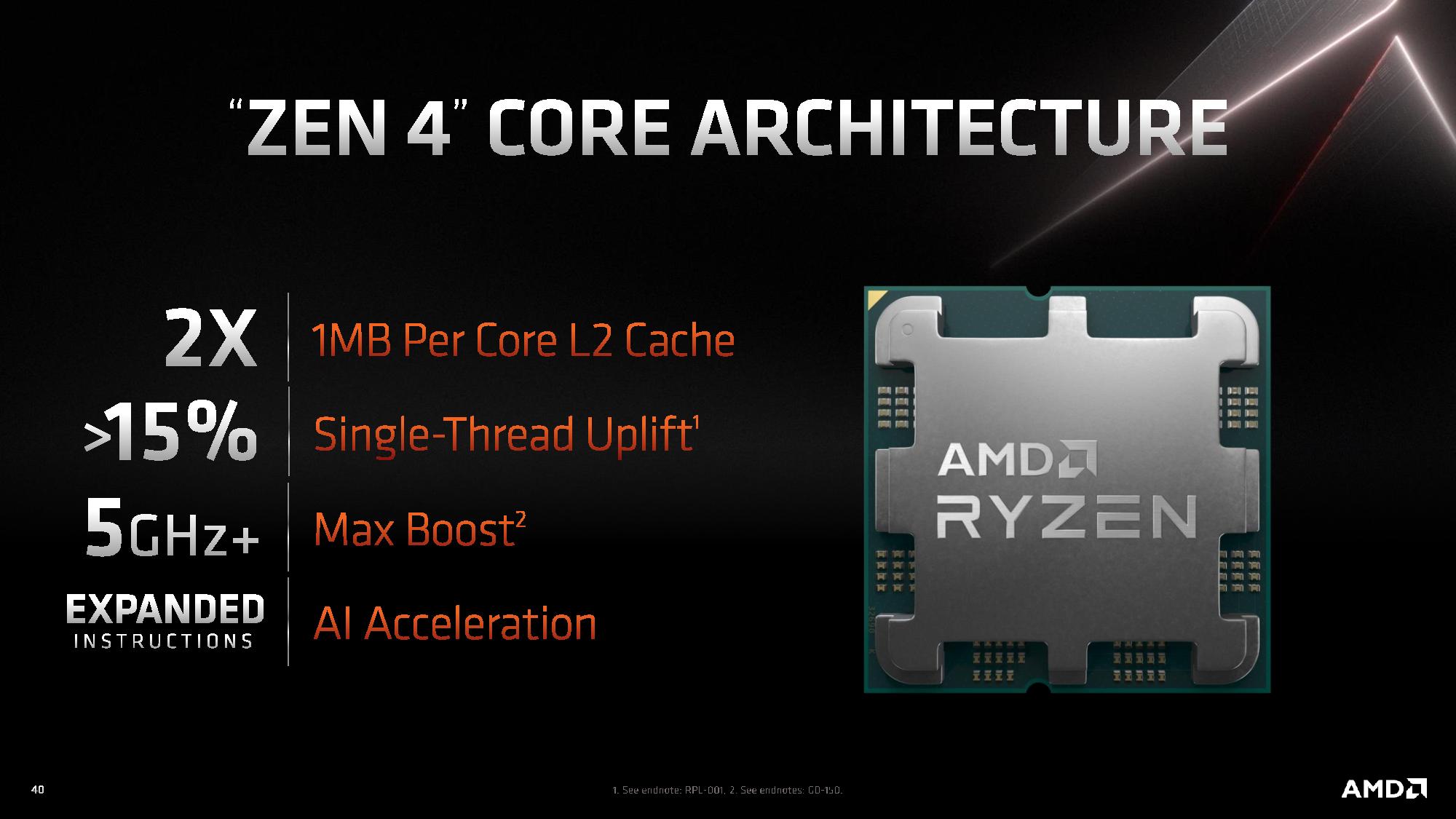
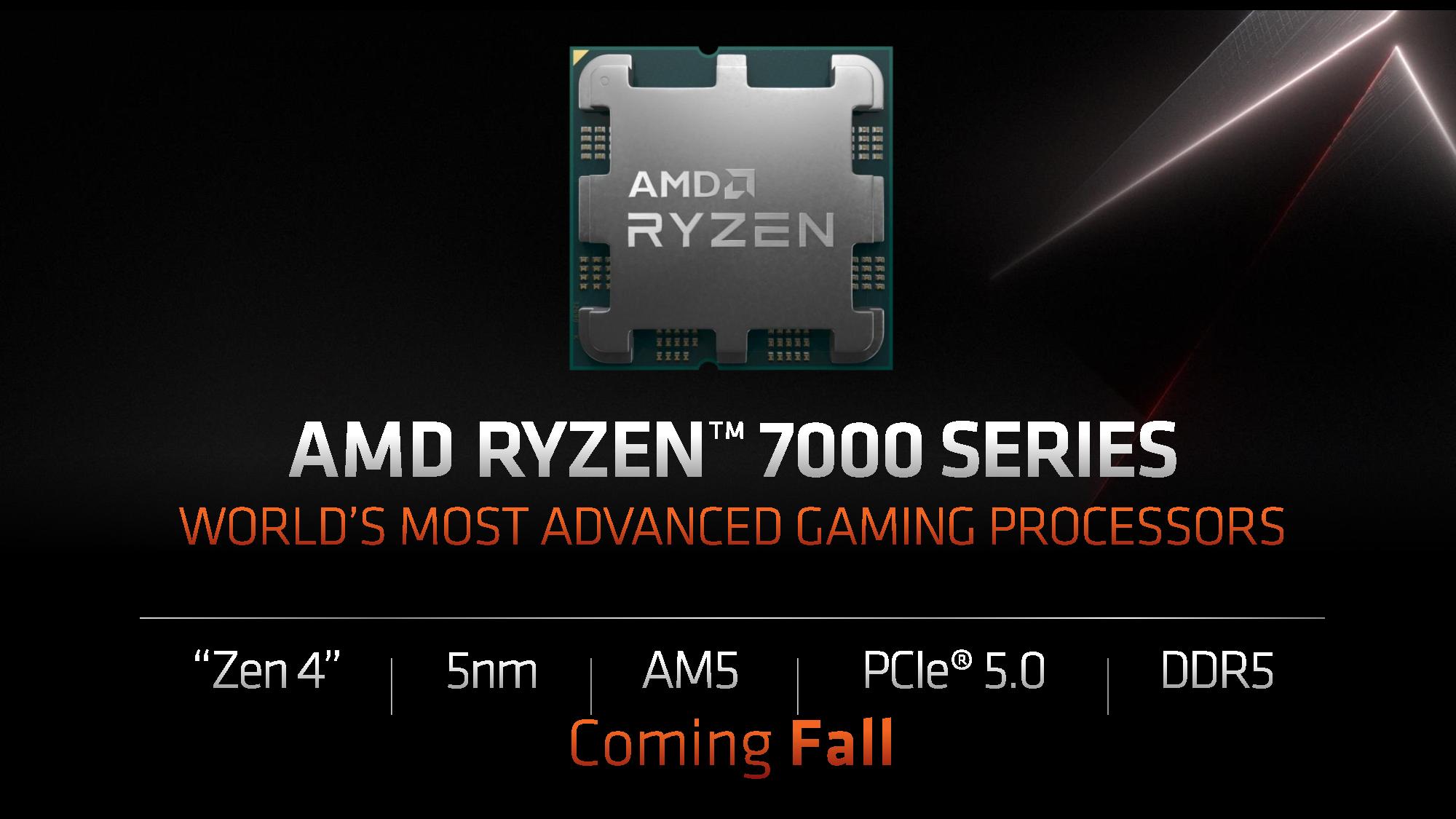
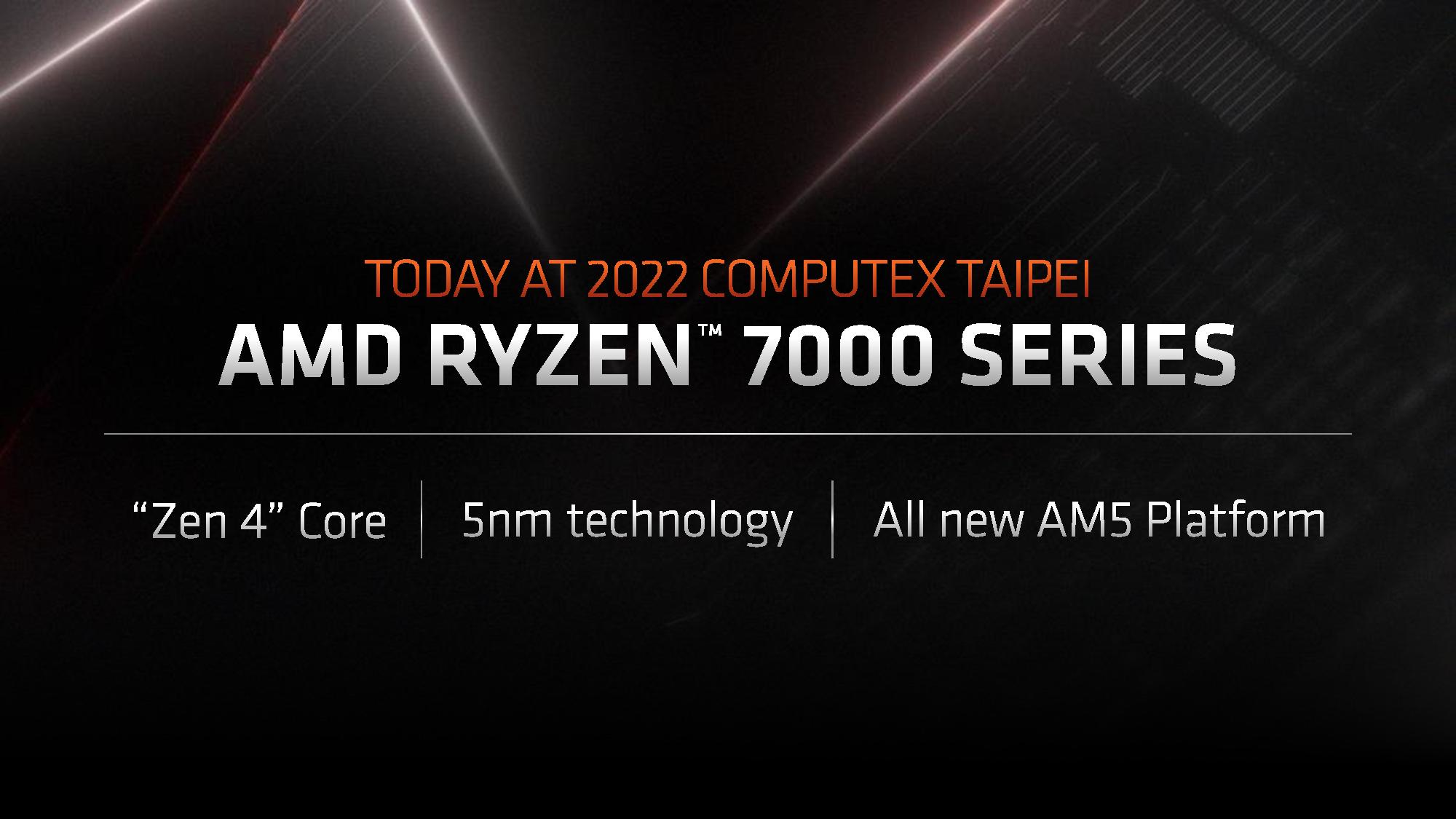

The biggest news for the 5nm Zen 4 chips comes as a 15% or better improvement in single-threaded performance over the previous-gen Zen 3-powered Ryzen 5000 processors. AMD tells us that this comes as a mixture of instruction per cycle (IPC) and frequency improvements, but won't share the specific percentage each factor contributes until later. AMD says the chips will reach 'significantly above' a 5 GHz peak frequency and even demoed a 16-core model hitting 5.5 GHz. However, that comes with the standard caveat that this frequency only applies to a single core during a light bursty workload, just as we've seen with Zen 2 and Zen 3 processors.
That means the 15%+ figure isn't based solely on IPC improvements, but improved single-thread performance does boost performance across the board as it is amplified as workloads spread across the cores. To that effect, AMD also boosted the maximum power delivery of the AM5 socket (PPT) that will house the Ryzen 7000 chips to 170W, a 28W increase over the previous-gen AM4 socket's 142W peak. If AMD sticks to its standard use of PPT x 1.35x = TDP, that means we'll see AM5 socket chips top out at a 125W TDP. We'll dive into performance comparisons a bit further below, but it looks like we'll see a closer-than-expected race between Ryzen 7000 and Intel's Alder and Raptor Lake chips.
The Ryzen 7000 processors come with expanded instructions for AI acceleration, but AMD isn't sharing details yet. However, we know from the Gigabyte hack that Zen 4 supports AVX-512 instructions, so these are likely the unnamed instructions. If so, that oddly places Intel's chips at a disadvantage as they have disabled AVX-512 functionality due to the hybrid architecture.
AMD has also doubled the L2 cache per core to 1MB for Zen 4, giving the execution cores a heftier slab of near memory for workloads. However, with Intel's chips, we've seen larger L2 caches primarily benefit data center workloads. Larger L2 caches generally reduce L3 cache accesses (theoretically by ~40% in this case), which reduces contention on the fabric, thus enabling better scalability and performance in all-core workloads — as opposed to enabling big boosts to single-threaded work. This is to say there's a chance Zen 4's increased L2 capacity will pay off more handsomely for the EPYC Genoa server chips than it will for most desktop PC applications.

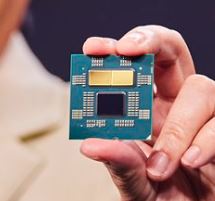
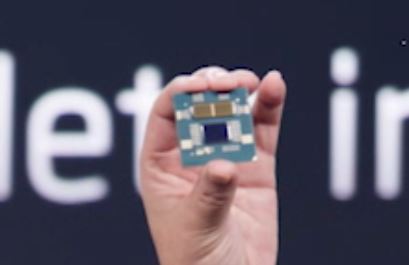
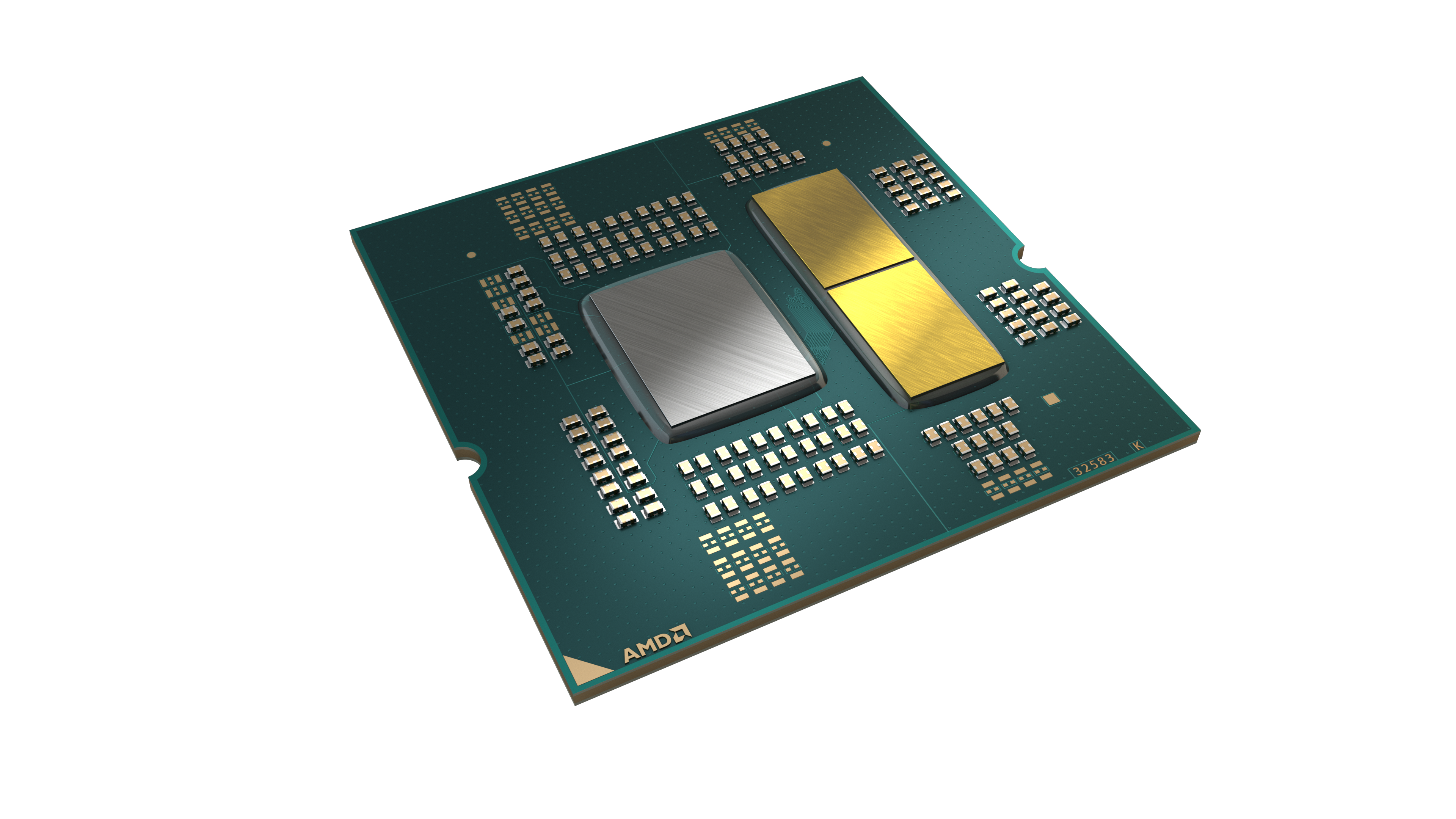
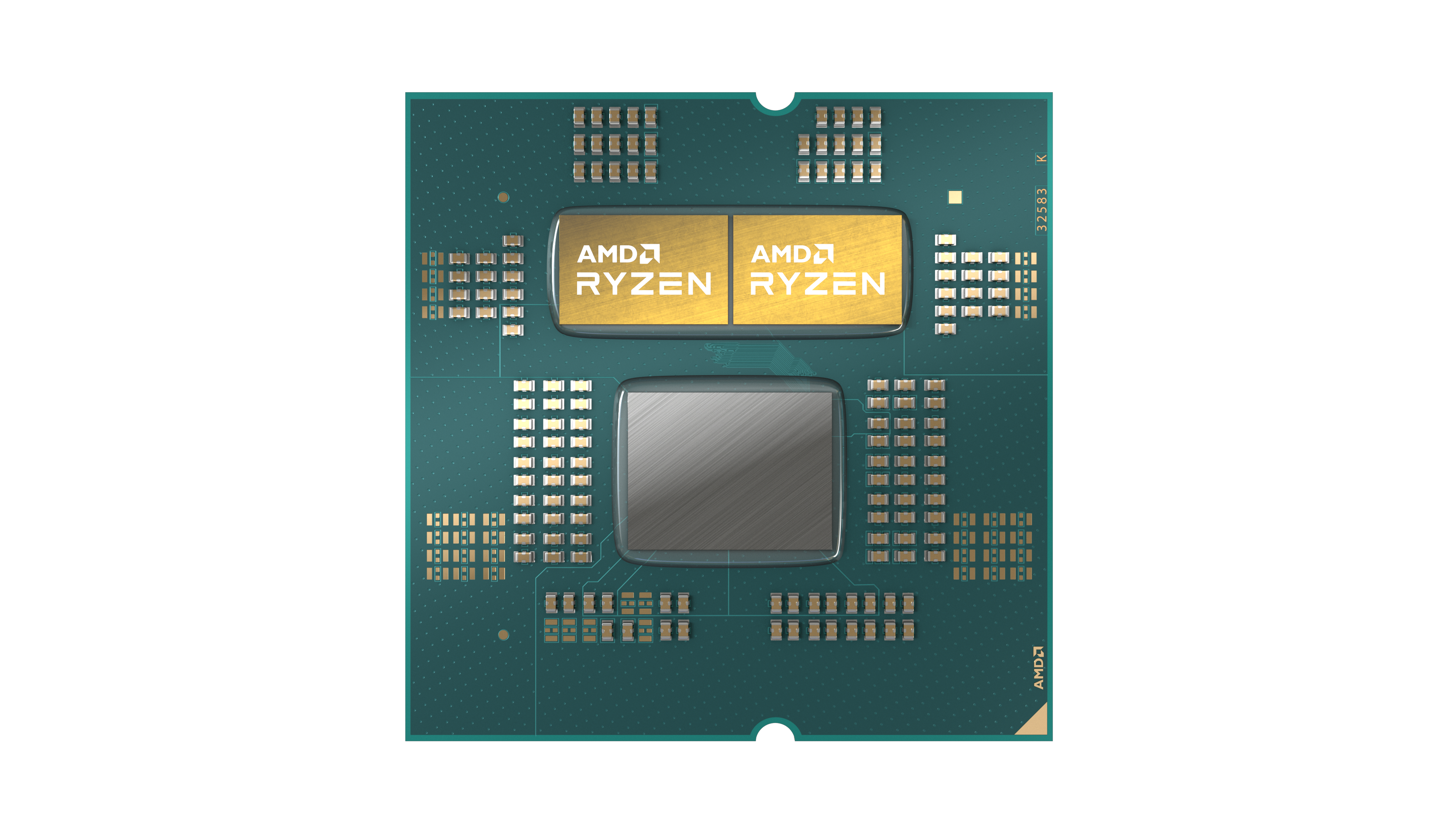

Here we can see both a block diagram of the chip and a close-up of a bare Ryzen 7000 chip from the keynote. The chip houses two 5nm core chiplets, each sporting eight cores. AMD says these are based on an optimized version of TSMC's high-performance 5nm process technology, likely referring to N5, and they are placed much closer together than we've seen with previous Ryzen core chiplets. In addition, the actual pics show what appears to be a shim between the two core chiplets, which is likely to maintain an even surface atop the two dies. It is also possible that this close orientation is due to some type of advanced packaging interconnect between the two chips (CoWoS-R?), but that seems unlikely. AMD has surprised us before, though — time will tell.
The all-new I/O die comes with the 6nm process and houses the PCIe 5.0 and DDR5 memory controllers along with a much-needed addition for AMD — the RDNA 2 graphics engine. The new 6nm I/O die also has a low-power architecture based on features pulled in from AMD's Ryzen 6000 chips, so it has enhanced low power management features and an expanded palette of low-power states.
The Ryzen 7000 chips support up to 24 lanes of the PCIe 5.0 interface directly from the socket, and although the company hasn't divulged memory frequencies, the test notes include a benchmark with the 16-core chip running DDR5-6000 CL30. It's unclear if those are stock frequencies or XMP/overclock values (AMD tends to use XMP profiles for its benchmarks). AMD recently touted that it expects to have exceptional DDR5 overclockability, making the memory controllers sound impressive from afar. A newly-filed patent also points to a possible upcoming automatic memory overclocking feature.
AMD hasn't shared the specifics of its integrated GPU, but we have seen this iGPU in action running between 1,000 and 2,000 MHz in a recent benchmark submission. The RDNA 2 engine supports up to four display outputs, including DisplayPort 2 and HDMI 2.1 ports. All Ryzen 7000 chips will support some form of graphics, so it doesn't appear there will be graphics-less options, like Intel's F-series, for now. The integrated RDNA 2 engine will help address one of AMD's key weaknesses in the OEM market, not to mention be helpful for enthusiasts for troubleshooting or if they just need a basic display out.
Surprisingly, the new I/O die appears to have roughly the same area as the previous-gen 12nm I/O die. However, given that the 6nm die is far denser than the 12nm die from GlobalFoundries, meaning it has far more transistors, it's safe to assume the integrated GPU has consumed a significant portion of the transistor budget (possibly due in part to onboard iGPU cache).
The large 6nm die will inevitably add to cost, as 6nm will be far more expensive than the mature 12nm I/O die. If it's any consolation, the iGPU's close proximity to the DDR5 controllers also resident on the die should provide plenty of bandwidth from the main memory, though we'll have to wait to learn how many cores the graphics engine has. This iGPU engine appears to be for basic display capabilities only, so you shouldn't expect any meaningful gaming performance.
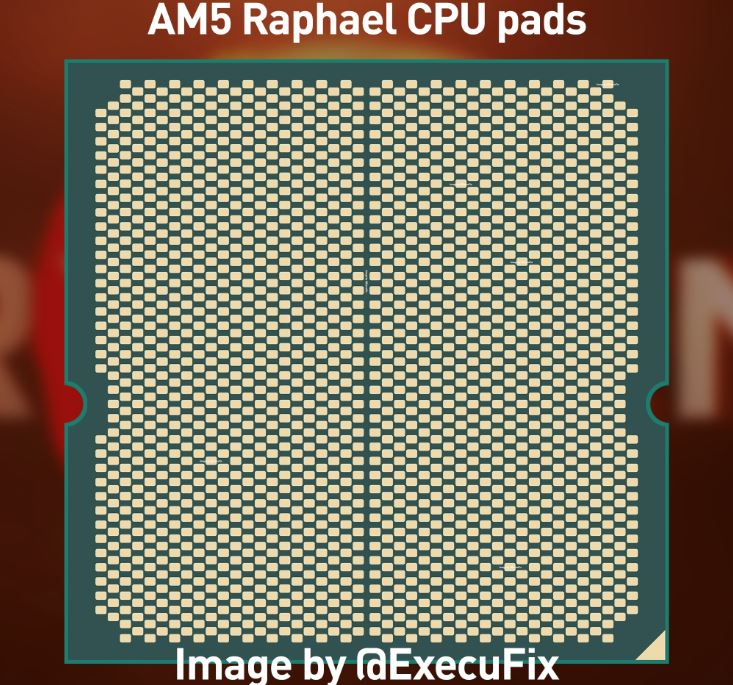
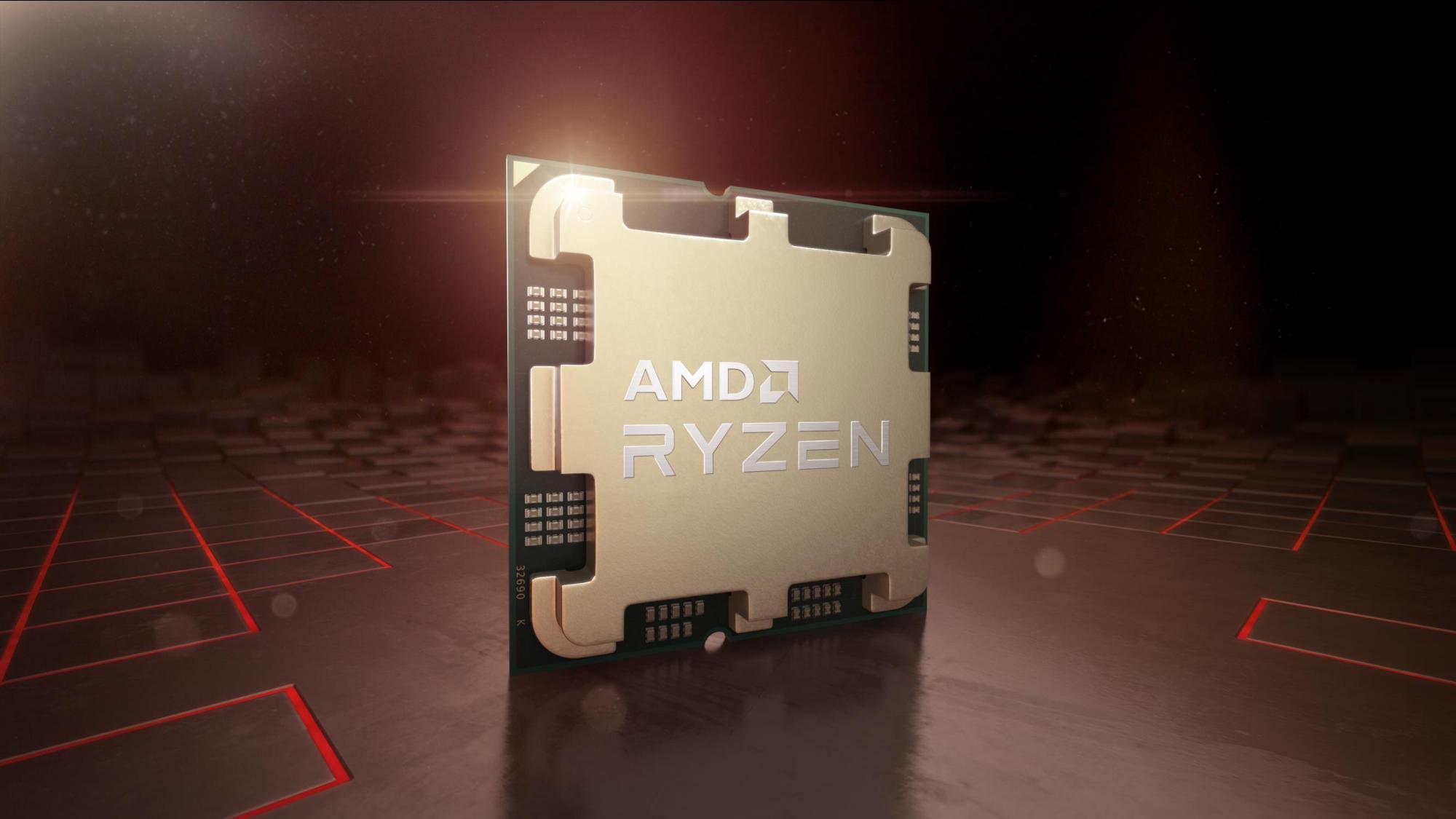


Ryzen 7000's package looks busy with a full complement of capacitors spread out across the PCB. This eliminates the need for capacitors that face into the socket like the large arrays of capacitors we see spread among the LGA pads on Intel's processors (Ryzen 7000 pad image from @ExecuFix - not official from AMD).
Ryzen's capacitor arrangement necessitates the great-looking heatspreader (though it might be hard to clean). Still, it also likely eliminates any chance of AMD adding a third die to the chip, meaning these chips will probably top out at 16 cores and 32 threads, just like the previous-gen Ryzen 5000 series. AMD has told us that AM5 will be a similarly long-lived socket as we saw with AM4, so it's possible we could see higher core counts in this socket in the future.
Get Tom's Hardware's best news and in-depth reviews, straight to your inbox.
AMD Zen 4 'Raphael' Ryzen 7000: AMD Demos and Spitballing Performance
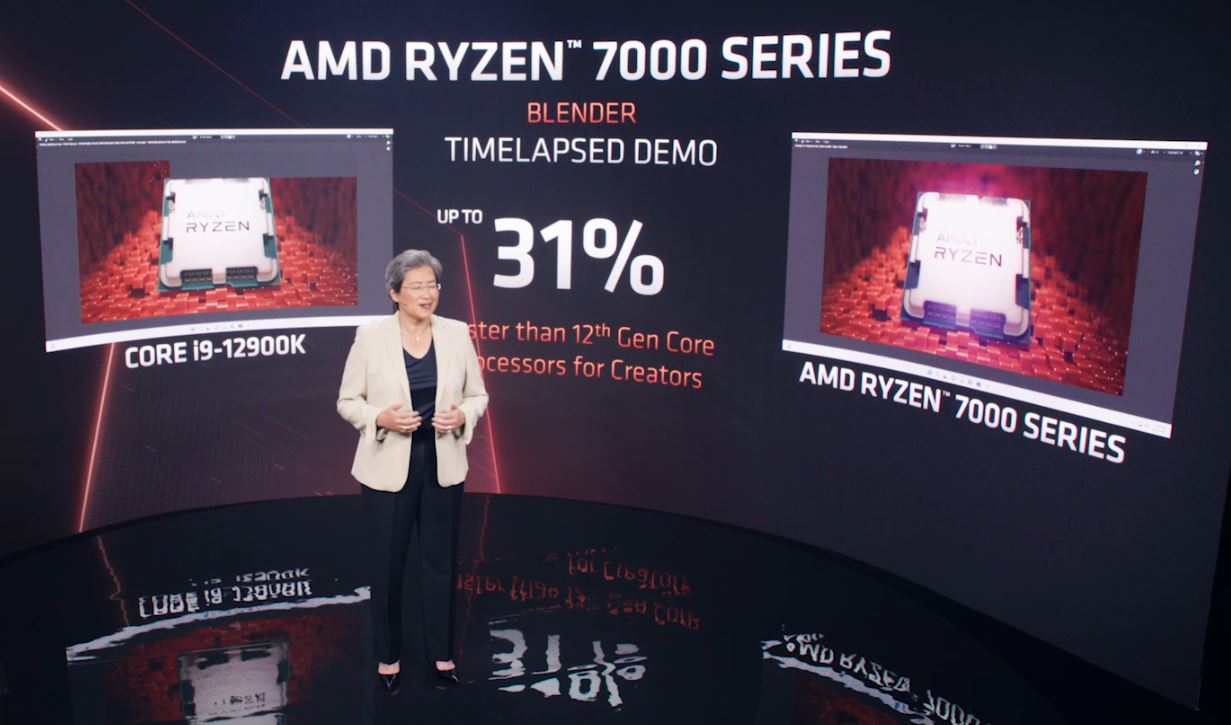


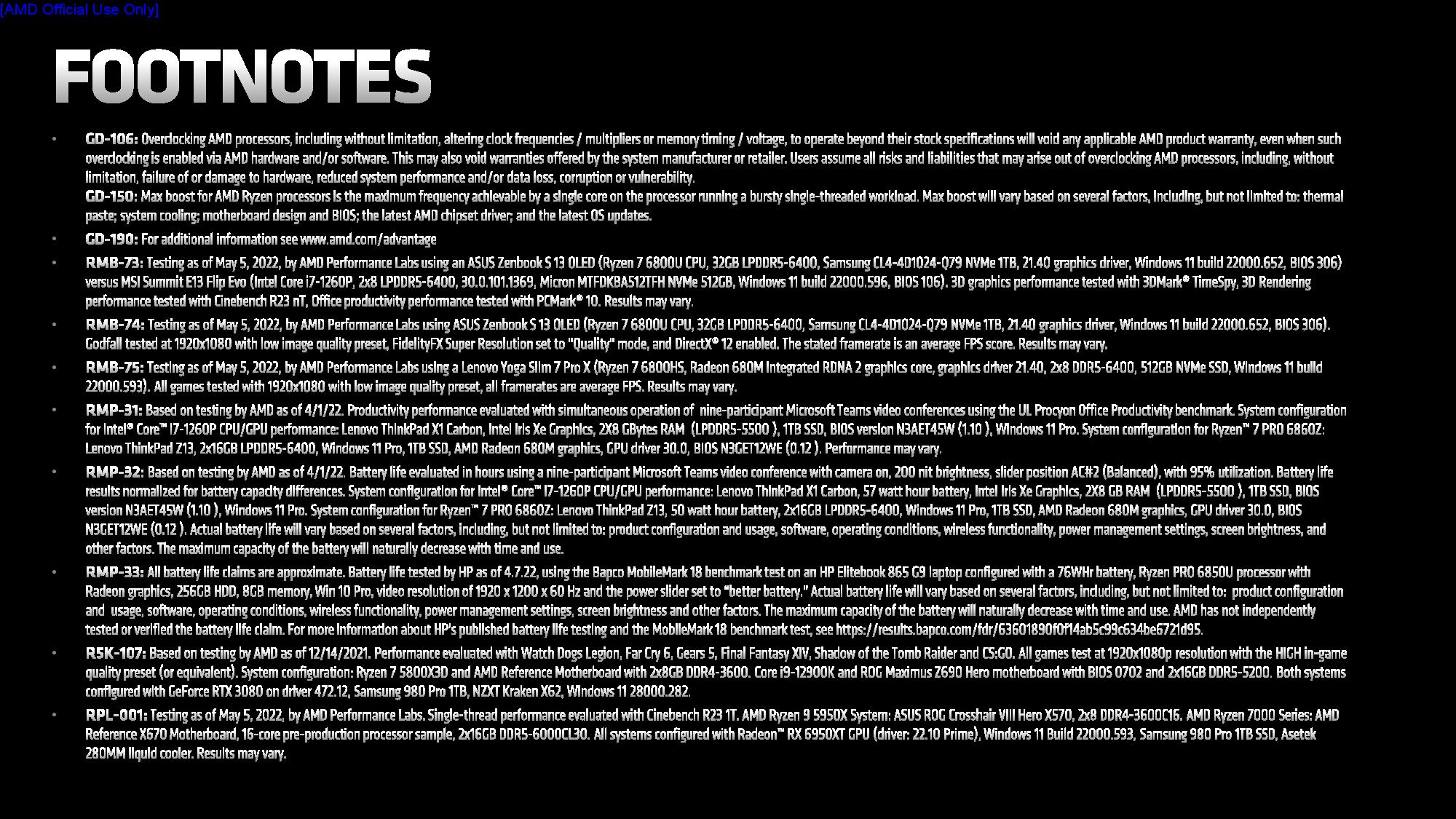
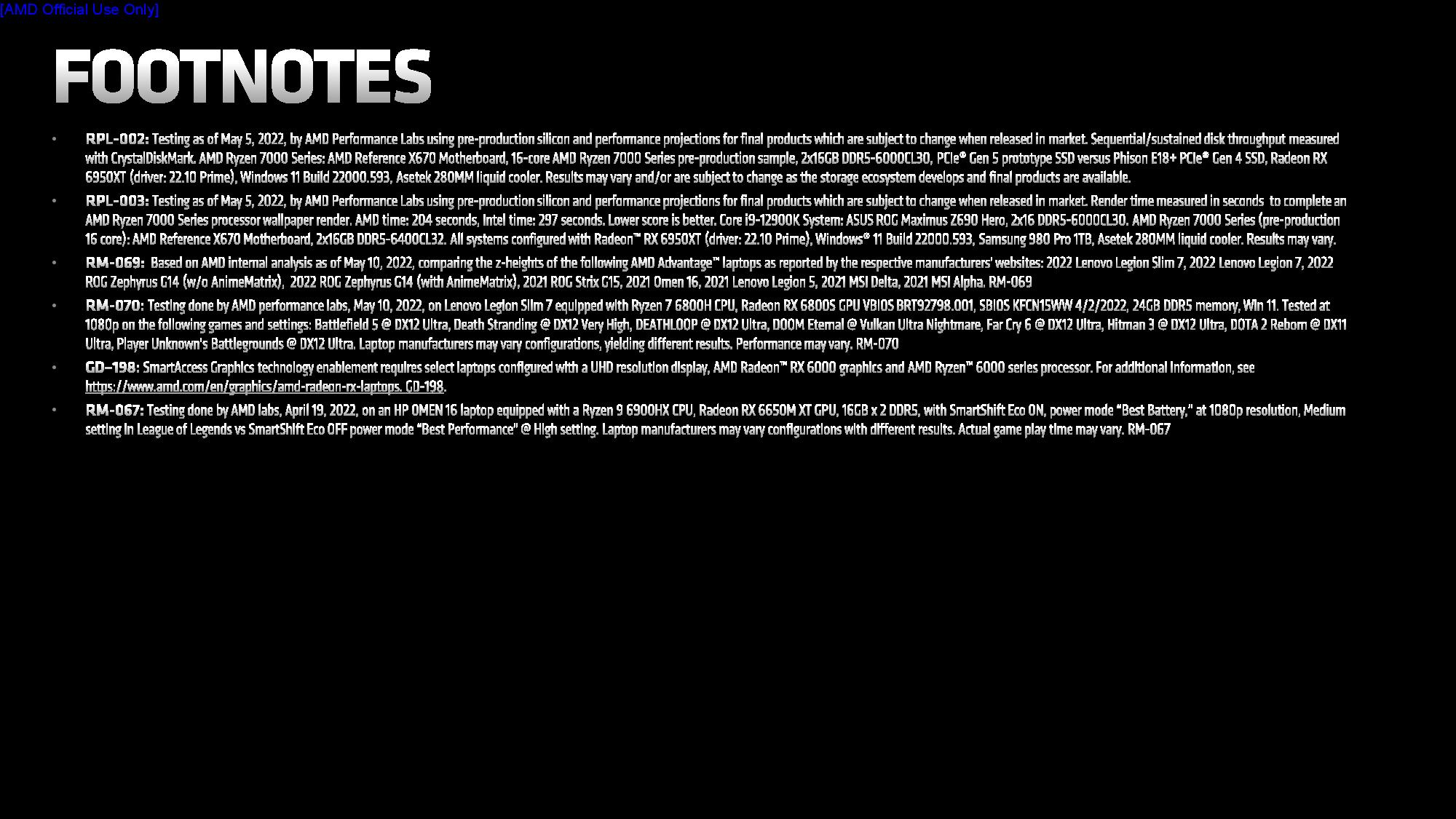
As with all vendor-provided benchmarks, you should approach these results with caution. AMD demoed a 16-core pre-production Ryzen 7000 chip running the Ghostwire: Tokyo game, and as you can see from the third image, the chip topped out at an incredible 5.52 GHz. That matches the current desktop PC frequency leader, the 5.5 GHz Intel Core i9-12900KS. Naturally, that comes with caveats: AMD only guarantees that its chips can reach the peak frequency on a single core, and this pre-production chip might not come to market with a 5.5 GHz spec. (It sure looks likely that it will, though.)
AMD also demoed its 16-core Ryzen 7000 chip, presumably with 32 threads, against the 16-core 24-thread Core i9-12900K in a Blender render (we included the test notes in the above album). The Ryzen 7000 processor completed the render of a Ryzen 7000 chip in 204 seconds, which is 31% less time than the 12900K's time of 297 seconds.
Blender supports AVX-512, and although we aren't sure the Ryzen 7000 desktop chips will come with the feature enabled, we do know the Zen 4 microarchitecture supports the instructions. This could contribute to AMD's lead over Intel in this benchmark, which would be an odd occurrence indeed: Intel pioneered the powerful AVX-512 but chose to disable it with the Alder Lake chips due to the complexities associated with scheduling work to the correct cores in the x86 hybrid architecture.
Additionally, although we know that the 5nm process should be more power-efficient than the 7nm process, it is possible that the higher 170W provided by the AM5 socket could help improve all-core performance here, specifically during an AVX-powered workload. (The 142W PPT limit hampered performance with the 12- and 16-core Ryzen 5900X and 5950X during all-core workloads.) AMD hasn't confirmed that Ryzen 7000 could take advantage of the additional power, though. It will be interesting to see comparisons of multi-threaded performance in a broader spate of benchmarks. Still, we also have to remember that Raptor Lake will come with four more e-cores and higher clock rates than the 12900K, so we expect the competition in threaded work to be much closer than we see here.
AMD also measured Ryzen 7000's +15% single-threaded performance improvement by putting an unnamed pre-production 16-core Zen 4 Ryzen 7000 processor, presumably the flagship, with DDR5-6000 memory up against the 16-core Ryzen 9 5950X with DDR4-3600 in a Cinebench R23 single-threaded test. Unfortunately, AMD didn't share any specific benchmark scores, but this does give us a basic idea of how the chips will fare against Intel's Alder Lake in this specific benchmark.
We're referencing our own test data below, but it tells us what we need to know. Intel's Alder Lake chips hold the lead in the Cinebench R23 single-threaded benchmark, and they also hold the overall lead in single-threaded performance against AMD's Ryzen 5000 chips. Below we've boiled this down into a head-to-head with the flagship Alder Lake Core i9-12900K against the Ryzen 9 5950X.
| Tom's Hardware | Cinebench R23 Single-Thread (% - CB Marks) | Overall Single-Thread Geomean |
| Core i9-12900K DDR5 — 5.2 GHz | 100% (1,968) | 100% |
| Ryzen 9 5950X DDR4 — 4.9 GHz | 83.9% (1,652) | 84.9% |
According to our tests, the Core i9-12900K is roughly 16% faster than the Ryzen 9 5950X in the Cinbench R23 benchmark, and AMD claims its 16-core Ryzen 7000 model is 15% faster than the 5950X. That means the Zen 4 chips will likely pull to parity with Intel's Alder Lake in this benchmark.
Additionally, you can see that the Cinebench R23 result tracks well with our more expansive overall measurement of single-threaded performance that we use for our rankings in our CPU Benchmark hierarchy. This measurement encompasses performance in three single-threaded tests, and its similarity to the Cenbench scores suggests that Zen 4 could basically match Alder Lake in overall single-threaded performance.
Intel's Raptor Lake will come with the same Golden Cove architecture for its performance cores (P-cores) as we saw with Alder Lake, but we expect Intel to dial up the clock rates to boost performance. As such, we can expect quite a battle for single-threaded superiority between Ryzen 7000 and Raptor Lake.
- 2017: Zen 1 — +52% IPC
- 2019: Zen 2 — +16% IPC
- 2020: Zen 3 — +19% IPC
- 2022: Zen 4 — ?
Seeing the TSMC 5nm process hit 5.52 GHz during the gaming demo was incredibly impressive, but AMD hasn't shared what percentage of its >15% single-threaded gain comes from either frequency or IPC. If AMD has its chip running at 5.5 GHz during its Cinebench R23 test we covered above, we could be looking at comparatively smaller single-digit IPC gains over Zen 3 than we're accustomed to seeing with new AMD architectures.
That could mean a signficant slowing of IPC gains compared to the previous generations of Ryzen processors. Still, we have to remember that a myriad of other considerations, including power management and multi-core boosts, also impact overall performance heavily. Additionally, it isn't unheard of for AMD to tout higher performance numbers as it reaches final silicon (like with Zen 1's IPC measurements). In other words, we'll have to wait a bit longer for a clearer view of performance. As always, we won't know for sure until we snap the chips into the socket on our testbed.
AMD 600-Series Chipset with AM5 Socket: X670E Extreme, X670, and B650 Motherboards
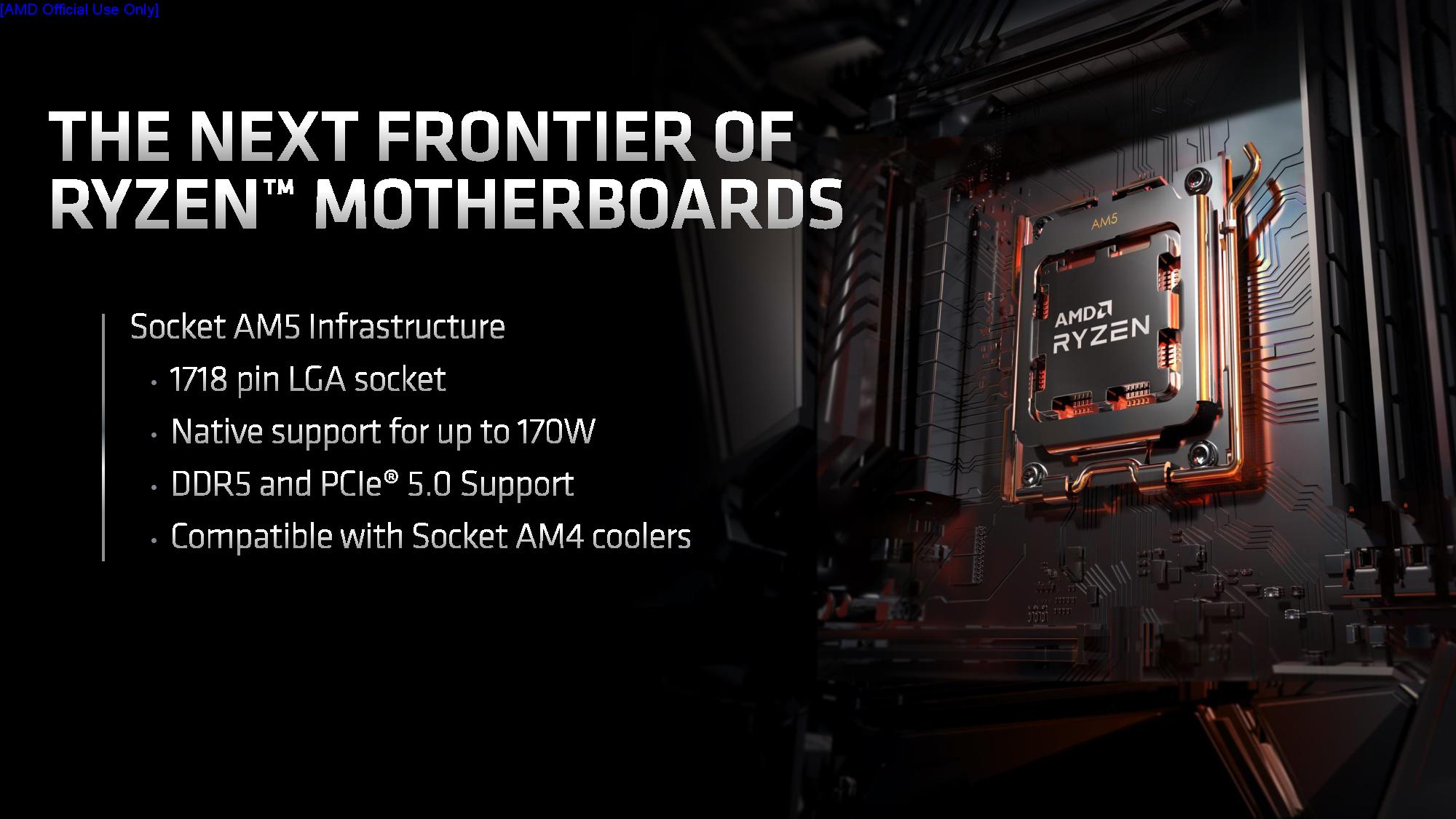
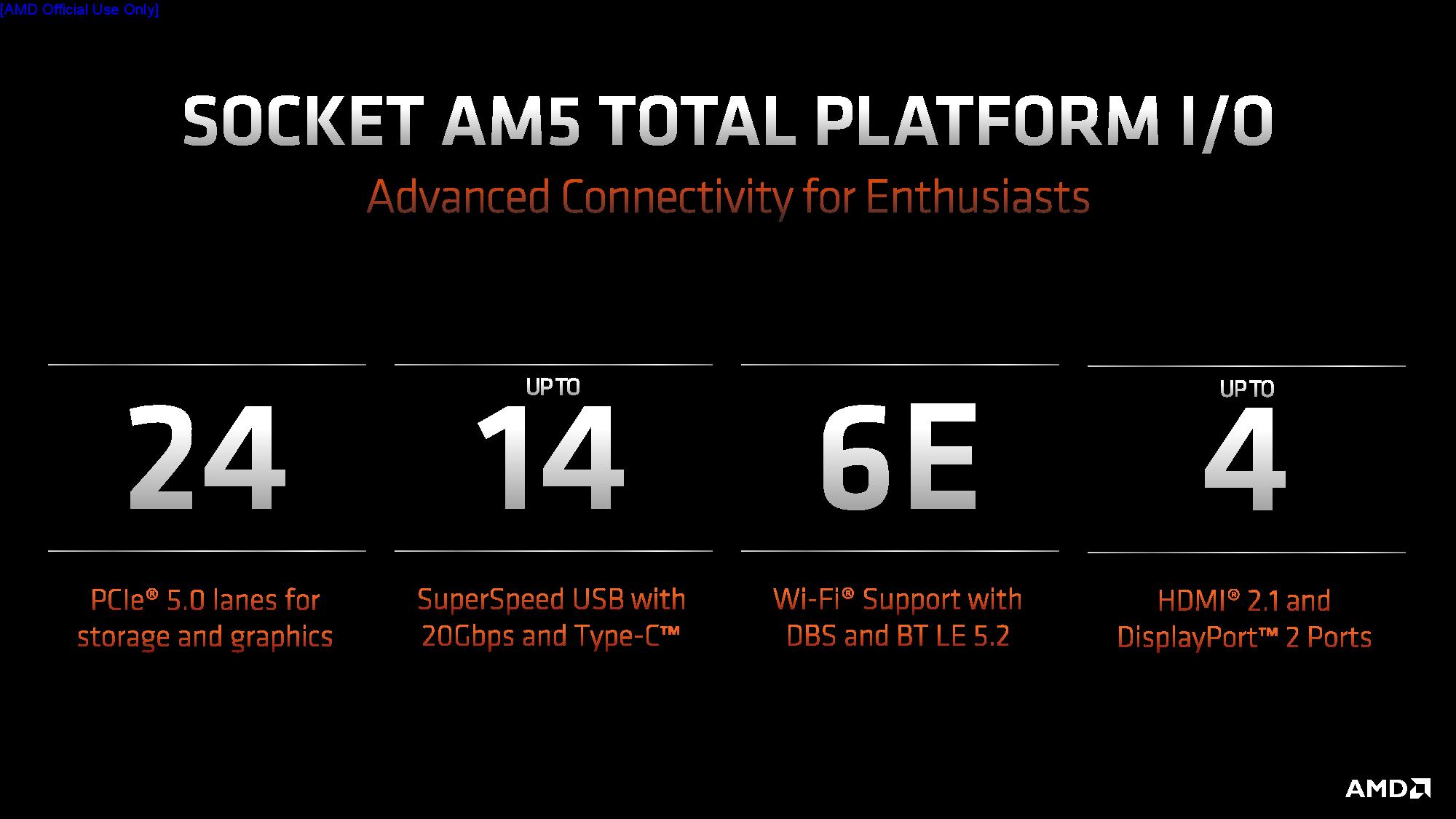

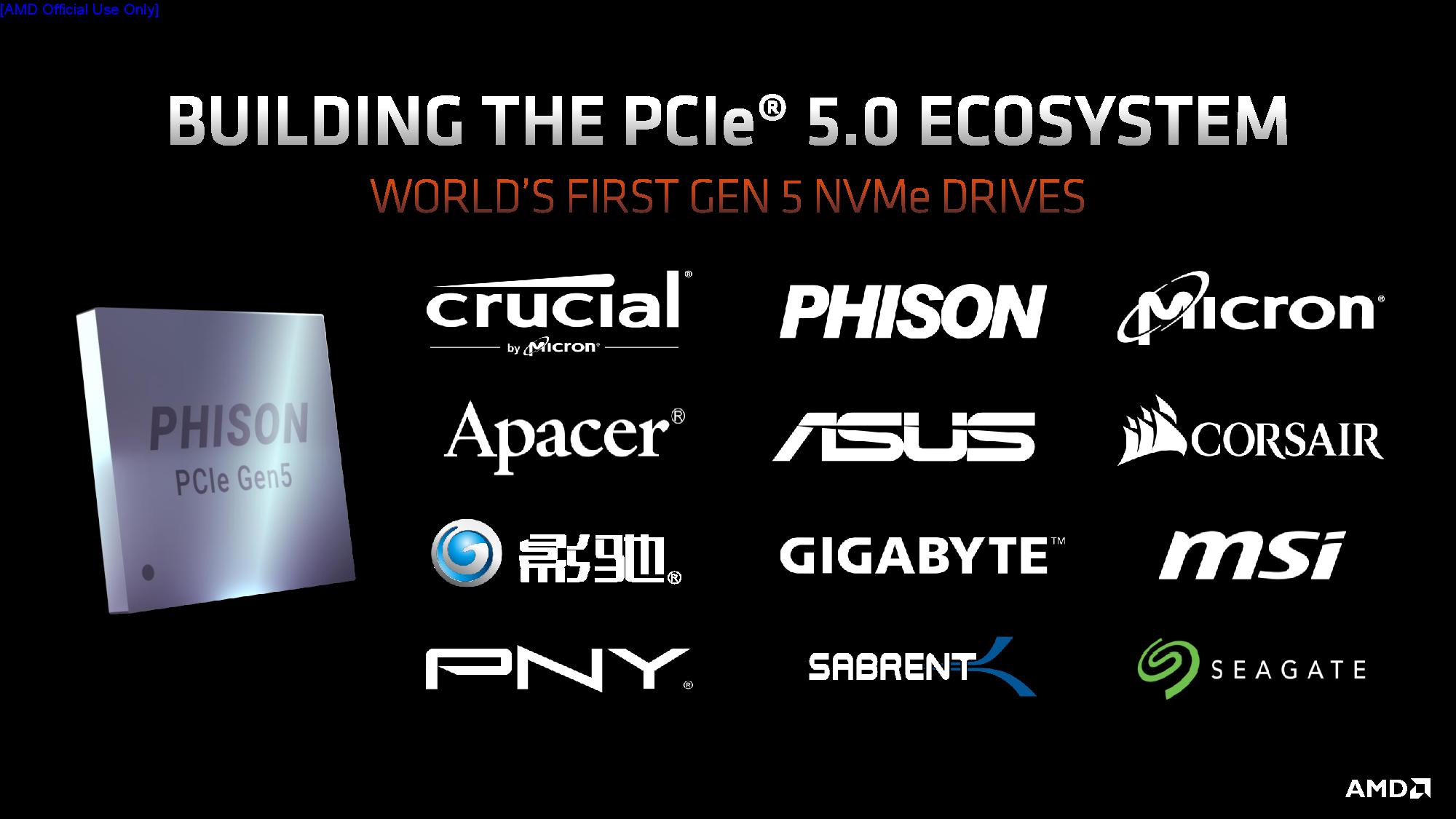
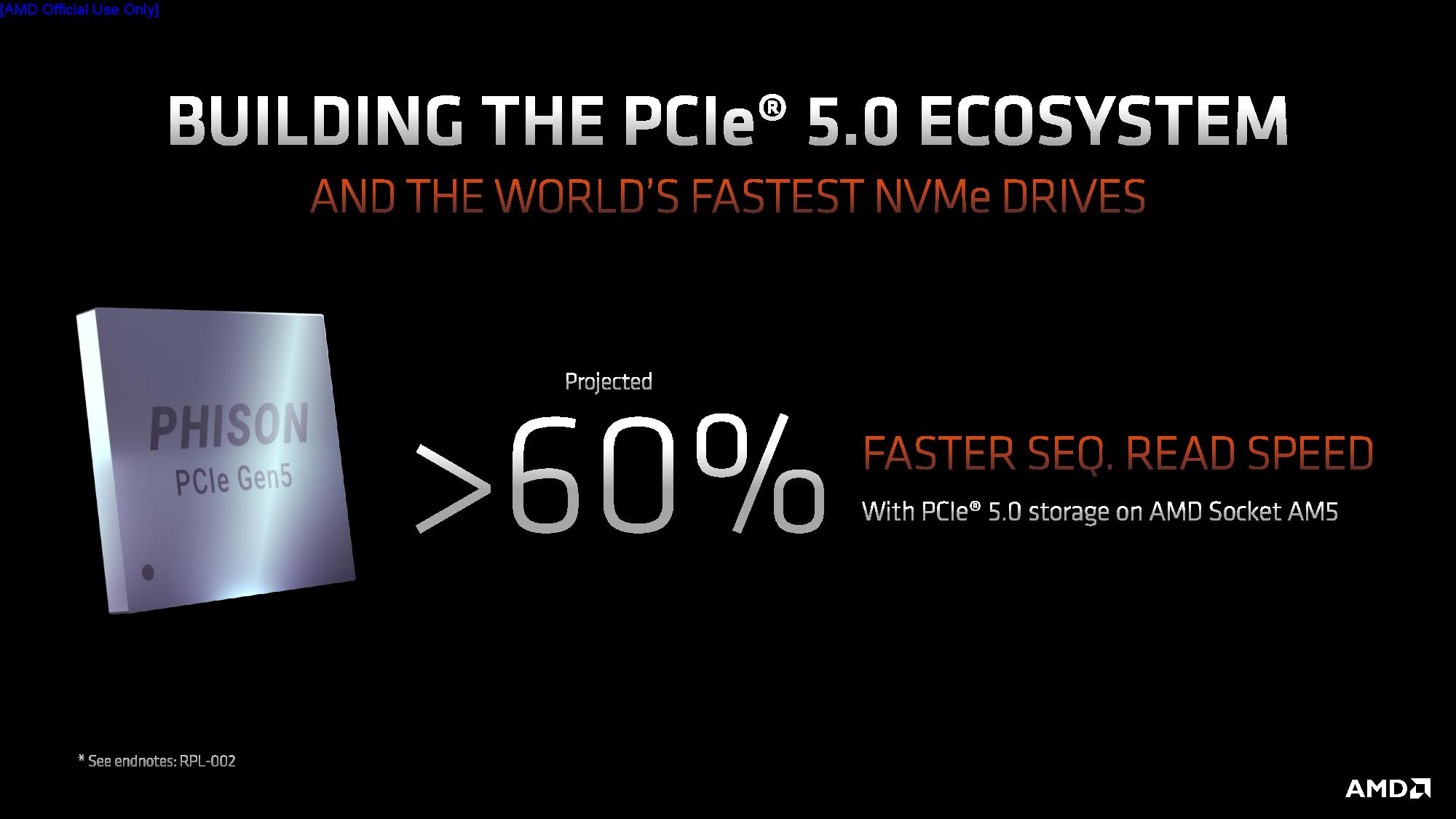
AMD's socket AM4 has soldiered on for five years across five CPU generations, four architectures, four process nodes, 125+ processors, and 500+ motherboard designs, so it's time for a new refreshed series of motherboards.
The Raphael processors will drop into a new AM5 socket that supports both the PCIe 5.0 and DDR5 interfaces, matching Alder Lake on the connectivity front. This new socket marks a big departure for AMD — the company is moving from its long-lived Pin Grid Array (PGA) AM4 sockets to a Land Grid Array (LGA) AM5 layout. Despite the entirely different LGA1718 socket interface (1718 pins), the AM5 socket will still support AM4 coolers.
The Socket AM5 motherboards will offer up to 24 lanes of PCIe 5.0, the most PCIe 5.0 lanes direct from the socket in the industry. The chipset also supports up to 14 SuperSpeed USB ports up to 20Gbps and Type-C, along with support for Wi-Fi 6E with DBS and BlueTooth LE 5.2. AMD hasn't specified, but the Wi-Fi 6E support likely comes as a discrete chip from the company's initiative with MediaTek (Edit: we've since seen confirmation of this through various motherboard spec sheets).
The X670E 'Extreme' chipset will support PCIe 5.0 for two graphics slots and one M.2 NVMe SSD port. This chipset is designed for motherboards that aim for extreme overclockability, carving out a new tier above AMD's standard lineup.
The X670 chipset powers the 'standard' high end motherboards and will come in multiple flavors with varying PCIe support. The M.2 port will support the PCIe 5.0 interface, but the first graphics slot can support either a peak of PCIe 4.0 or PCIe 5.0, which will vary by the motherboard. This offers a lower-cost sub-tier of PCIe 4.0 X670 motherboards.
The B650 chipset will support PCIe 5.0 for a single NVMe port, but only PCIe 4.0 for the graphics slot. This chipset also supports overclocking, but as per usual, you won't find as robust of power accommodations as you will with the more expensive boards.
Socket AM5 motherboards support up to four display outs via HDMI 2.1 Fixed Rate Link (FRL) and Displayport 1.4 High Bit Rate 3 (HBR3) outputs, powered by the RDNA 2 graphics engine onboard the 6nm I/O die in the Ryzen 7000 processors.
AMD is busy enabling the PCIe 5.0 SSD ecosystem with Phison, Micron, and Crucial. Crucial and Micron will have their first PCIe 5.0 SSDs in the market when AM5 motherboards arrive on the market. Additionally, the remainder of the names on the PCIe 5.0 ecosystem slide in the above album will use Phison PCIe 5.0 SSD controllers, meaning we'll soon see wide availability of even speedier drives.
That will come in handy for Ryzen 7000 systems — AMD claims a 60% performance gain in sequential read workloads with PCIe 5.0 SSDs. That is great for Microsoft's DirectStorage because it relies heavily upon sequential read throughput to reduce game loading times to roughly a second.


AMD showed five of the upcoming flagship X670E motherboards, with offerings from MSI, ASRock, ASUS, Gigabyte, and Biostar. You can find spec sheets for these boards now at the respective websites. AMD also confirmed that the Ryzen 7000 chips also feature the SVI3 power infrastructure that supports more power phases from the motherboard and enables faster voltage response.
AMD hasn't clarified its dual-chipset alignment yet, but recently leaked pictures of the MSI X670E motherboards and ASUS Prime X670-P Wi-Fi motherboards have confirmed many of the details we previously uncovered. According to our sources, AMD's mainstream B650 platform will come with a single chipset chip that connects to the Ryzen 7000 CPU via a PCIe 4.0 x4 connection, though documents we've seen say that a PCIe 5.0 connection is available on some AM5 processors.
Meanwhile, the enthusiast X670 platform employs two of these ASMedia chips (our sources confirm the chips are identical, not a north/southbridge-type arrangement), effectively doubling these connectivity options. These chipsets are daisy-chained together. This stands in contrast to AMD's approach with the current 500-series motherboards, which use different chips for the X- and B-series motherboards. The new approach will obviously provide cost and design flexibility advantages.
Finally, AMD has confirmed that the AM5 socket will only support DDR5 memory. The company says that DDR5 provides the extra performance to justify the cost, but we'll have to watch pricing closely. As we've reported, DDR5 pricing remains prohibitively expensive, but Micron expects PMIC/VRM supply to rebound in the second half of 2022, so we could see the situation improve as AMD's Zen 4 Ryzen 7000 processors come to market.
However, DDR5's more complex power circuitry and design mean that these modules will continue to command a premium over DDR4. DDR5 also has in-built ECC mechanisms for data at rest, which requires additional dies to provide the same memory capacity as DDR4. Though the pricing differences will become smaller over time, DDR5 will remain more expensive than DDR4, regardless of supply. We'll have to wait until closer to the launch to see how this impacts Ryzen 7000's platform costs.
The 5nm Zen 4 Raphael Ryzen 7000 chips and the accompanying 600-series chipsets are due on the market in Fall 2022, so we won't have to wait long.

Paul Alcorn is the Editor-in-Chief for Tom's Hardware US. He also writes news and reviews on CPUs, storage, and enterprise hardware.
-
hotaru251 zen 4 w/ integrated rdna2 graphics...Reply
finally.
only thing keeping me from building a zen4 this summer is the DDR5. I rather let it mature and get cheaper and faster still (as seen too many issues w/ ddr5 in systems still) -
Bikki We actually looking at a mere 3% IPC increase here if we exclude the 13% frequency boost. With all the advantage they have on TSMC 5nm, AM5, DDR5 ... we expected much more. In fact, TSMC says chip produce with 5mn node has 15% performance increase at same frequency, if AMD did nothing and just port zen 3 to 5nm they may actually have 15% IPC increase. I am really confused.Reply -
Iceman2022 ReplyBikki said:We actually looking at a mere 3% IPC increase here if we exclude the 13% frequency boost. With all the advantage they have on TSMC 5nm, AM5, DDR5 ... we expected much more. In fact, TSMC says chip produce with 5mn node has 15% performance increase at same frequency, if AMD did nothing and just port zen 3 to 5nm they may actually have 15% IPC increase. I am really confused.
Or you could literally just read the AMD slides that explicitly state that it's a 15% IPC increase. You can type but you can't read? How odd -
mdd1963 ReplyBikki said:We actually looking at a mere 3% IPC increase here if we exclude the 13% frequency boost. With all the advantage they have on TSMC 5nm, AM5, DDR5 ... we expected much more. In fact, TSMC says chip produce with 5mn node has 15% performance increase at same frequency, if AMD did nothing and just port zen 3 to 5nm they may actually have 15% IPC increase. I am really confused.
That '~15% performance increase' indeed does not seem all that impressive when coupled with a greater than 10-15% clock speed boost...; I will simply hope that the 7800X can at least surpass the 5800X3D in gaming, which is, of course, the most important workload of all! :) -
KyaraM Reply
From the article:Iceman2022 said:Or you could literally just read the AMD slides that explicitly state that it's a 15% IPC increase. You can type but you can't read? How odd
The quick snap is that AMD claims the Ryzen 7000 processors will have >15% more single-threaded performance than their Zen 3 predecessors (not IPC)
https://cdn.mos.cms.futurecdn.net/vUhEtvv249LAMnxJA6xGY5-970-80.jpg.webpYou mean this slide? It says literally nothing about IPC. Just a general statement about more single-thread performance, which is a function of clock speed, IPC, and cache. You can type, but you can't read? How odd. -
Iceman2022 Reply
You guys can't be serious right? They are claiming to be 30% faster in cinebench vs 12900k. How are they going to do that with a 3% IPC improvement over Zen 3. 😂😂😂😂😂 Use your heads a little bit peoplemdd1963 said:That '~15% performance increase' indeed does not seem all that impressive when coupled with a greater than 10-15% clock speed boost...; I will simply hope that the 7800X can at least surpass the 5800X3D in gaming, which is, of course, the most important workload of all! :) -
Iceman2022 Reply
So AMD is claiming to beat the 12900k in cinebench by 30% with a 3% IPC gain over Zen 3.... That's what you're telling me. 🤭😂😂KyaraM said:From the article:
https://cdn.mos.cms.futurecdn.net/vUhEtvv249LAMnxJA6xGY5-970-80.jpg.webpYou mean this slide? It says literally nothing about IPC. Just a general statement about more single-thread performance, which is a function of clock speed, IPC, and cache. You can type, but you can't read? How odd. -
TerryLaze Reply
The 12900 has 8 P (full) cores and 8 e cores while the zen one will have 16 full cores. ~30% more cores= ~30% more score. (I know this is not exact, but that's the general idea)Iceman2022 said:You guys can't be serious right? They are claiming to be 30% faster in cinebench vs 12900k. How are they going to do that with a 3% IPC improvement over Zen 3. 😂😂😂😂😂 Use your heads a little bit people -
dk382 Reply
They are not claiming to be 30% faster than the 12900K in Cinebench. They are claiming to be 30% faster in Blender during an all-core workload. You are mixing up the different claims AMD has made and seem confused as a result. To be clear, this is exactly what AMD has claimed if you actually look at the footnotes and understand the slides: 1) a 16-core Zen 4 CPU got a 15% higher Cinebench R23 single threaded score than the 5950X, 2) a 16-core Zen 4 CPU got a 30% faster render time in an all core Blender test versus the 12900K. This means a 15% total single-core performance uplift over the 5950X in that one test. Single-threaded gaming performance may be different. Other tests may be different. But it is what it is, just a 15% higher ST cinebench score than the previous gen, even after clocks were boosted by 12.25%. That means the IPC gain is pretty small for this test (~2.5%). We may be returning to the era where Intel was clearly better for single-threaded performance while AMD is clearly better for multi-threaded.Iceman2022 said:You guys can't be serious right? They are claiming to be 30% faster in cinebench vs 12900k. How are they going to do that with a 3% IPC improvement over Zen 3. 😂😂😂😂😂 Use your heads a little bit people -
KyaraM Reply
They claim that for Blender, not Cinebench. You know, Blender, multi-core application that scales very well with more cores in CPU rendering which was tested here? 16 full P-cores vs. 8P and 8E-cores? With the E-cores combined having the performance of a Skylake CPU from, what, 6 years ago at best?Iceman2022 said:So AMD is claiming to beat the 12900k in cinebench by 30% with a 3% IPC gain over Zen 3.... That's what you're telling me. 🤭😂😂
Seriously, I think you really need to work on reading comprehension here, and the one to "use your head"...

